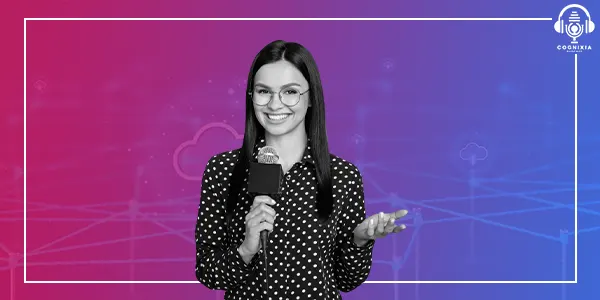Hello everyone, and welcome back to the Cognixia podcast. Every week we bring you a fresh episode on this podcast covering something new from the world of emerging digital technologies and management. In today’s episode, we talk about two very popular platforms, which are highly renowned global brands. The app of one of them would likely be on most of your phones, I am sure.
Today, we talk about how Netflix uses AWS to provide a seamless global service to its users around the world. Like most global businesses today, cloud computing is integral for Netflix to function. Netflix uses a wide range of AWS services to provide a seamless service to its users around the world. This includes Amazon Elastic Cloud Compute, Amazon Simple Storage Service, Amazon CloudFront, Amazon Rekognition, Amazon Kinesis, AWS Lambda, AWS Auto Scaling, and many more.
Did you know that Netflix began as a mail-based DVD rental business on 29 August 1997? Since then, Netflix has evolved greatly and has become a streaming giant.
Let us take a quick look at how Netflix uses these components of AWS.
First, Amazon Elastic Compute Cloud, popularly referred to as Amazon EC2. EC2 offers the broadest and deepest compute platform, with over 600 instances and a choice of the latest processor, storage, networking, operating system, and purchase model to help meet the requirements of the user’s workloads. Amazon EC2 provides virtual machines that Netflix uses to run its streaming applications. Since, EC2 is highly scalable, thus enabling Netflix can easily add or remove servers as required to meet changing demands.
Next, let us look at Amazon Simple Storage Service, popularly referred to as Amazon S3. Amazon S3 is an objective storage service offering industry-leading scalability, data availability, security, and performance. Using S3, users can store and protect any amount of data for just about any use case – from data lakes to cloud-native applications, and even mobile applications. S3 offers cost-effective storage classes, easy-to-use management features, cost optimization, data organization, access-control configurations, etc. based on user requirements. Amazon S3 provides object storage for Netflix to store its content on the cloud. S3 is highly durable and available, enabling Netflix to offer content to its users reliably anytime, anywhere.
Another service Netflix uses is Amazon CloudFront. Amazon CloudFront is a content delivery network operated by AWS. It offers a globally -distributed network of proxy servers to cache content, like web videos, or any other bulky media content, more locally to the users, enabling better access speed for downloading and streaming the content. Netflix uses CloudFront to deliver its content to users all around the world. CloudFront’s speed and reliability help users start watching their shows and movies on the streaming platform quickly without major delays.

Amazon Rekognition is a great tool from AWS to automate and lower the cost of image recognition and video analysis with machine learning. It enables users to solve their most pressing computer vision needs even without machine-learning skills. Rekognition works very well to detect faces and objects in the content. Using Amazon Rekognition, Netflix offers content recommendations to users based on their viewing history and creates personalized experiences for all users.
Amazon Kinesis is an AWS tool to collect, process, and analyze real-time video and data streams. It helps ingest, buffer, and process streaming data in real time to derive insights in minutes instead of days. It helps run your streaming applications on serverless infrastructure with a fully managed service. Using Kinesis, Netflix can seamlessly handle any amount of streaming data that may come from thousands of sources and process it with low latencies. Netflix also uses Kinesis to collect data about its users’ viewing behavior. Kinesis helps Netflix analyze this data to improve its recommendations as well as other features.
Next, let us look at AWS Lambda. AWS Lambda helps run code without thinking about servers or clusters. Using AWS Lambda run code without provisioning or managing infrastructure. It also automatically responds to code execution requests at any scale, which could be ranging from a few dozen events a day to hundreds of thousands of events per second. It helps respond to high demand with provisioned concurrency. Netflix can respond to events by running the requisite code using AWS Lambda, saving money and resources while keeping its streaming service running smoothly.
While we are at it, we would also like to talk about AWS Auto Scaling. AWS Auto Scaling helps scale applications to optimize performance & costs. It helps monitor applications and automatically adjust capacity to maintain steady, predictable performance at the lowest possible cost. Netflix uses AWS Auto Scaling to automatically scale its infrastructure up or down based on demand. It also helps Netflix to ensure that it has sufficient capacity to handle spikes in traffic without overspending on resources.
Last, we would also like to highlight how Netflix uses yet another AWS tool – AWS Global Accelerator. AWS Global Accelerator helps improve application availability, performance, and security using the AWS Global Network. It can help improve network performance for applications by up to 60%. It can help achieve deterministic routing by removing DNS cache dependencies. The global accelerator also helps protect applications from DDoS attacks closer to the source. Netflix uses AWS Global Accelerator to improve the performance of its streaming services for users around the world. Global Accelerator helps route traffic to the nearest AWS region, which in turn, helps reduce latency and improve the overall user experience.
These are some of the top ways in which Netflix uses the amazing features offered by AWS to offer a seamless, personalized, desirable experience to its users. I am sure, you now have a slightly better idea of how Netflix is so popular and how AWS supports Netflix in its great functioning. Next time you log into Netflix and are watching a show or movie on it, think about how many different functions and features, and technologies have to operate and connect perfectly for you to be able to have the experience of watching whatever you are, without even moving from your couch or chair.
With that, we come to the end of this week’s episode of the Cognixia podcast. We hope you enjoyed listening to us today as much as we enjoyed creating & recording this episode. If you want to sharpen your skills in any emerging digital technologies, we recommend you check out our live online instructor-led courses on our website, www.cognixia.com. You can contact us via the chat function on our website, and learn more about our promotions and offers, as well as get more information about our courses. Adding new skills and certifications to your repertoire may just be the thing you need to take the next leap in your career. So, get in touch with us today!
Signing off for now, until next week then!
Happy learning!




